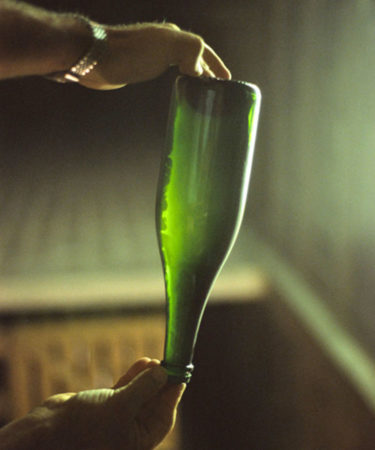In 2014, Champagne house Veuve Clicquot introduced QR codes on the labels of its Cave Privées and La Grande Dame bottles. When scanned, these codes reveal important information about the bottle’s blend, dosage, and disgorgement date.
Krug introduced a similar system in 2012. The company prints ID codes on all of its bottles that reveal similar information about their blends, ages, and disgorgement dates.
While blending and aging are concepts most wine drinkers are familiar with, it’s unlikely disgorgement figures into the average drinker’s lexicon. Even if it does, many are unaware of the impact disgorgement has on how Champagne ages, and the vital intel a disgorgement date provides to those buying bottles.
Don't Miss A Drop
Get the latest in beer, wine, and cocktail culture sent straight to your inbox.Disgorgement is the process of removing dead yeast cells, called lees, from Champagne bottles. Lees are a byproduct of the secondary fermentation that gives Champagne its bubbles. The wine then spends a period of time aging on them before they’re coaxed into the bottle’s neck, rapidly frozen, and released under pressure (or disgorged).
Disgorgement impacts the taste and character of Champagne because it affects the rate at which the wine develops. While in contact with lees, yeast protects wine from oxygen and slows the aging process. After disgorgement, however, there’s no such protection and the wine starts to age at a much faster rate. Eventually, the wine loses all fruit flavors and aromas and “dies.”
Knowing a bottle’s age can help avoid picking up a dead bottle of Champagne. The problem is, only a quarter of all Champagne bottles list the wine’s vintage on their labels. The rest are “non-vintage” blends, made using still base wines from different years.
If you’re buying a bottle of non-vintage (NV) Champagne, then, the disgorgement date is a valuable clue to the wine’s age. (And, more importantly, whether or not it’s good to drink.)
Winemakers generally age NV Champagnes for up to one year after disgorgement. When stored in the right conditions (out of direct sunlight and at a constant, cool temperature), the wine is then good to drink for the next two to three years.
So, if a Champagne label has a disgorgement date of one year prior to the day you’re buying it, you can be sure it’ll taste fresh and is still safe to buy. But anything with a disgorgement date of more than a couple of years, you’ll want to avoid — or at least think twice about buying.
While premium Champagne houses like Krug are transparent with disgorgement information, not all Champagne houses list disgorgement dates on labels. But the practice is becoming increasingly common.
Bruno Paillard was the first house to start sharing disgorgement information with customers, starting in 1983. Other Champagne houses that now also list disgorgement dates include Ayala, Charles Heidsieck, Lanson, Mumm, and Piper-Heidsieck.
